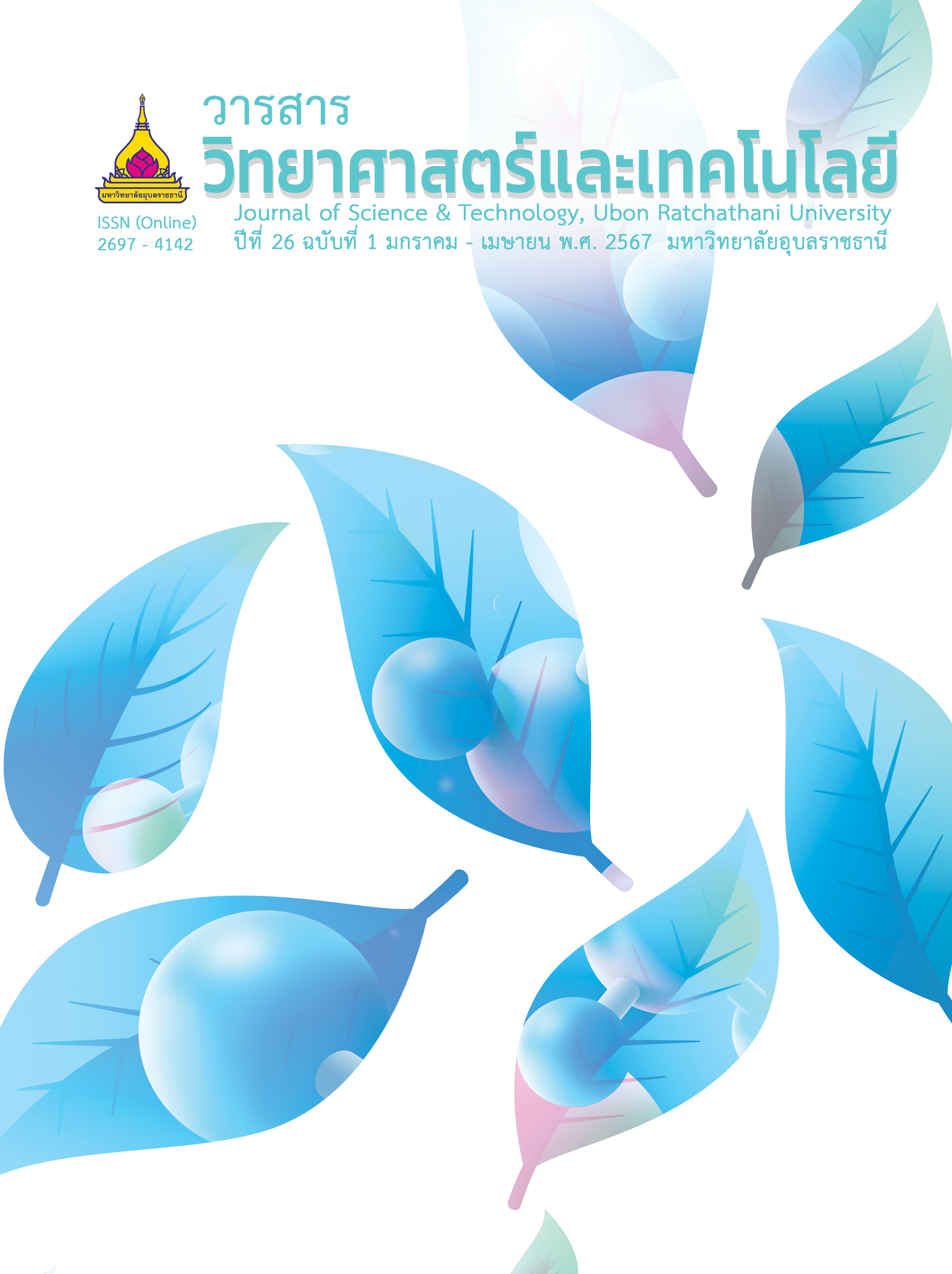การพัฒนาผลิตภัณฑ์ชาสมุนไพรที่มีฤทธิ์ต้านอนุมูลอิสระจากสังกรณีและตรีชวา เพื่อเป็นเครื่องดื่มเพื่อสุขภาพ
Main Article Content
บทคัดย่อ
สังกรณี (Crossandra infundibuliformis) และตรีชวา (Justicia betonica) เป็นพืชสมุนไพรที่ถูกใช้มานานในประเทศไทย เนื่องจากมีสรรพคุณทางการแพทย์ที่หลากหลาย งานวิจัยนี้มีวัตถุประสงค์เพื่อพัฒนาผลิตภัณฑ์ชาสมุนไพรจากพืชทั้งสองชนิดเพื่อเป็นเครื่องดื่มเพื่อสุขภาพ จากการวัดปริมาณน้ำอิสระ และปริมาณความชื้นของใบพืชสมุนไพรทั้งสองชนิดที่ผ่านการทำแห้ง พบว่าใบสังกรณีและตรีชวาแห้งมีปริมาณน้ำอิสระเท่ากับ 0.547±0.0040 และ 0.562±0.0021 ตามลำดับ และปริมาณความชื้นน้อยกว่าร้อยละ 6 การนำสารสกัดจากใบของพืชสมุนไพรทั้งสองชนิดมาวิเคราะห์ปริมาณฟีนอลิกและฟลาโวนอยด์ทั้งหมดที่สกัดได้ รวมถึงฤทธิ์ต้านอนุมูลอิสระด้วยวิธี 2,2-diphenyl-1-picrylhydrazyl (DPPH) assay, 2,2'-azino-bis (3-ethylbenzothiazoline-6-sulphonic acid) (ABTS) assay และ ferric ion reducing antioxidant power (FRAP) assay พบว่าสารสกัดจากใบสังกรณีมีปริมาณฟีนอลิกและฟลาโวนอยด์ทั้งหมดที่สกัดได้ และฤทธิ์ต้านอนุมูลอิสระมากกว่าสารสกัดจากใบตรีชวา ในการศึกษานี้ได้พัฒนาผลิตภัณฑ์ชาสมุนไพร 5 สูตร ซึ่งมีอัตราส่วน (ร้อยละ) ของใบเตย : ใบสังกรณี : ใบตรีชวาที่ต่างกัน คือ 20 : 80 : 0 (สูตร 1), 20 : 60 : 20 (สูตร 2), 20 : 40 : 40 (สูตร 3), 20 : 20 : 60 (สูตร 4) และ 20 : 0 : 80 (สูตร 5) และศึกษาการยอมรับทางประสาทสัมผัสของผลิตภัณฑ์ด้วยวิธี 9-point Hedonic scale จากนั้นศึกษาคุณค่าทางโภชนาการของผลิตภัณฑ์ที่ได้รับการยอมรับมากที่สุด จากการศึกษาพบว่าผลิตภัณฑ์ชาสมุนไพรสูตร 2 ได้รับการยอมรับจากผู้บริโภคมากที่สุดจากการประเมินลักษณะปรากฏ สี กลิ่น รสชาติ รสฝาด และความชอบโดยรวม ด้วยคะแนน 7.0±1.2, 7.1±1.2, 6.7±1.4, 6.4±1.3, 6.2±1.4 และ 6.7±1.1 ตามลำดับ จากการตรวจสอบคุณค่าทางโภชนาการของชาสมุนไพรสูตร 2 พบว่าให้พลังงาน โปรตีน คาร์โบไฮเดรต ใยอาหาร วิตามินเอ วิตามินบีสอง แคลเซียม และเหล็ก โดยไม่ให้ไขมัน คอเลสเตอรอล และโซเดียม ดังนั้นสมุนไพรสังกรณีและตรีชวามีศักยภาพที่จะพัฒนาเป็นผลิตภัณฑ์ชาสมุนไพรเพื่อสุขภาพได้
Article Details

อนุญาตภายใต้เงื่อนไข Creative Commons Attribution-NonCommercial-NoDerivatives 4.0 International License.
บทความที่ได้รับการตีพิมพ์เป็นลิขสิทธิ์ของ วารสารวิทยาศาสตร์และเทคโนโลยี มหาวิทยาลัยอุบลราชธานี
ข้อความที่ปรากฏในบทความแต่ละเรื่องในวารสารวิชาการเล่มนี้เป็นความคิดเห็นส่วนตัวของผู้เขียนแต่ละท่านไม่เกี่ยวข้องกับมหาวิทยาลัยอุบลราชธานี และคณาจารย์ท่านอื่นๆในมหาวิทยาลัยฯ แต่อย่างใด ความรับผิดชอบองค์ประกอบทั้งหมดของบทความแต่ละเรื่องเป็นของผู้เขียนแต่ละท่าน หากมีความผิดพลาดใดๆ ผู้เขียนแต่ละท่านจะรับผิดชอบบทความของตนเองแต่ผู้เดียว
เอกสารอ้างอิง
Mazahir, M. and et al. 2022. Extraction and determination of bioactive compounds and antioxidant activity of buckwheat seed milling fractions. Food Science and Technology. 42: e81721.
Wang, F. and et al. 2022. Antioxidative stress effects of Humulus japonicus extracts on neuronal PC12 cells. Food Science and Technology. 42: e101921.
Phakamus, S. and et al. 2018. Development of Yanang mixed herb tea products. Burapha Science Journal. 23(3): 1682-1695. (in Thai)
Poswal, F. and et al. 2019. Herbal teas and their health benefits: A scoping review. Plant Foods for Human Nutrition. 74(3): 266-276
Musika, L. and Musika, T. 2021. Development of healthy shallot herbal tea (Allium ascalonicum L.) with antioxidant activities. Journal of Food Technology, Siam University. 16(2): 148-159. (in Thai).
Pengproh, R. and et al. 2019. Effect of antioxidant and crude extract of Strobilanthes nivea with traditional herbs on inhibition of some pathogenic bacteria. Journal of Science and Technology, Ubon Ratchathani University. 21(3): 208-244. (in Thai)
Food Intelligence Center Thailand. 2021. Food Market Share in Thailand. https://fic.nfi.or.th/ market-intelligence-market-share-detail.php? smid=328. Accessed 30 July 2023. (in Thai)
Wong-arun, W. and et al. 2014. The Diversity of Medicinal Plants in Sam Roi Yod Fresh Water Marsh. Research Project, Rajamangala University of Technology Rattanakosin. (in Thai)
Association Official Analytical Chemists (AOAC). 2005. Official Methods of Analysis of AOAC International. 18th edition. Gaithersburg, MD: AOAC International.
Ruangyuttikarn, W. and et al. 2013. Thunbergia laurifolia leaf extract mitigates cadmium toxicity in rats. ScienceAsia. 39: 19-25.
Tan, K.W. and Kassim, M.J. 2011. A correlation study on the phenolic profiles and corrosion inhibition properties of mangrove tannins (Rhizophora apiculata) as affected by extraction solvents. Corrosion Science. 53(2): 569-574.
Imam, M.Z. and et al. 2011. Antioxidant activities of different parts of Musa sapientum L. ssp. Sylvestris fruit. Journal of Applied Pharmaceutical Science. 1(10): 68-72.
Raj, V.K. and et al. 2016. Comparative evaluation of hepatoprotective effects of exotic fruits and common vegetables extracts on CCl4 induced hepatotoxicity: an in vitro study. International Journal of Pharmaceutical Sciences and Research. 7(8): 3388-3393.
Pereira, A.C.S. and et al. 2014. Effect of antioxidant potential of tropical fruit juices on antioxidant enzyme profiles and lipid peroxidantion in rats. Food Chemistry. 157(15): 179-185.
Tan, Y.P. and Chan, E.W.C. 2014. Antioxidant, antityrosinase and antibacterial properties of fresh and processed leaves of Anacardium occidentale and Piper betle. Food Bioscience. 6: 17-23.
Meilgaard, M.C. and et al. 2006. Sensory Evaluation Techniques. 4th edition. Boca Raton: CRC Press.
Baur, F.J. and Ensminger, L.G. 1977. The Association of Official Analytical Chemists (AOAC). Journal of the American Oil Chemists’ Society. 54(4): 171-172.
Thamkaew, G. and et al. 2021. A review of drying methods for improving the quality of dried herbs. Critical Reviews in Food Science and Nutrition. 61(11): 1763-1786.
Ismail, H.A. and et al. 2023. Browning in relation to enzymatic activities and phytochemical content in Terap peel (Artocarpus odoratissimus Blanco) during postharvest ripening. Horticulturae. 9: 57.
Theppakorn, T. 2012. Stability of catechins during processing of green tea and green tea beverage. Burapha Science Journal. 19(1): 189-198. (in Thai)
Ministry of Public Health, Thailand. 2021. Notifications of the Ministry of Public Health: Tea from Plants. https://www. ratchakitcha.soc.go.th/DATA/PDF/2564/E/102/T_0008.PDF. Accessed 1 June 2023. (in Thai)
Kahkonen, M.P. and et al. 2001. Berry phenolics and their antioxidant activity. Journal of Agricultural and Food Chemistry. 49(8): 4076-4082.
Lim, Y.Y. and et al. 2007. Antioxidant properties of several tropical fruits: a comparative study. Food Chemistry. 103(3): 1003-1008.
Junsi, M. and et al. 2017. Phenolic and flavonoid compounds in aqueous extracts of Thunbergia laurifolia leaves and their effect on the toxicity of the carbamate insecticide methomyl to murine macrophage cells. Functional Foods in Health and Disease. 7(7): 529-544.
Martysiak-Zurowska, D. and Wenta, W. 2012. A comparison of ABTS and DPPH methods for assessing the total antioxidant capacity of human milk. Acta Scientiarum Polonorum, Technologia Alimentaria. 11(1): 83-89.
Berker, K.I. and et al. 2013. Modified folin-ciocalteu antioxidant capacity assay for measuring lipophilic antioxidants. Journal of Agricultural and Food Chemistry. 61(20): 4783-4791.
Xiao, H.W. and et al. 2017. Recent developments and trends in thermal blanching - A comprehensive review. Information Processing in Agriculture. 4(2): 101-127.


